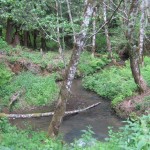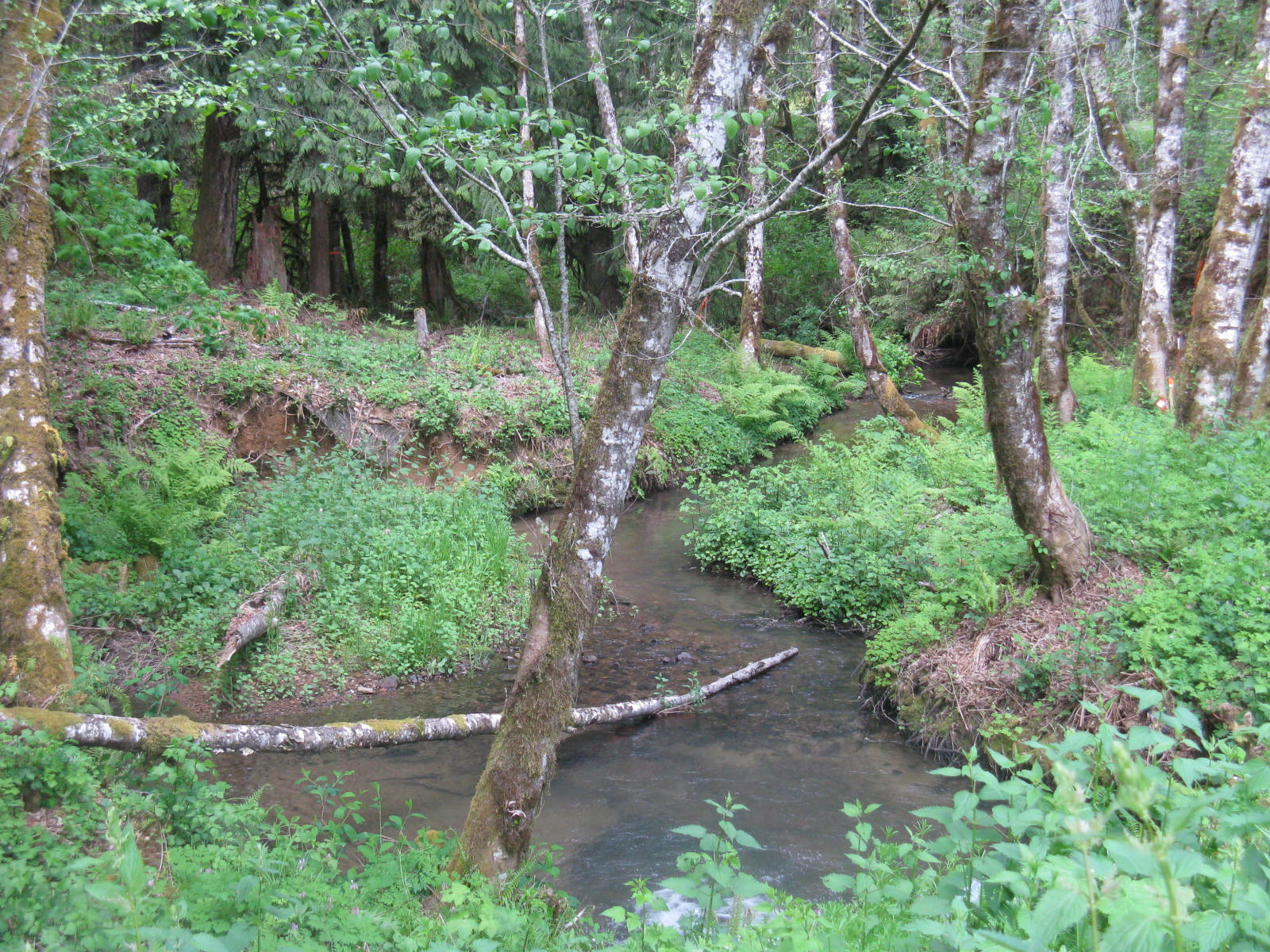 Fish Passage Enhancement Project at the Thomson’s
Fish Passage Enhancement Project at the Thomson’s
Andy and Maryrae Thomson’s family has lived and raised beef cattle on the land along Eber Creek, a tributary to Ferguson Creek, since 1881. The Thomsons chose to replace two undersized culverts that were acting as fish passage barrier with a bridge. For the Thomsons, their project with the Long Tom Watershed (LTWC) was a sound business decision as well as in-line with their values. The bridge let the fish swim freely upstream again while providing them with safer and year-round access to a section of their timber. The Thomsons hosted meetings for their neighbors in early conversations about the creek – you could say they carried the torch for local creek improvement first.
Sub-Watershed Enhancement Program
Ferguson Creek was the first basin to participate in the Council’s Subwatershed Enhancement Program, designed as a peer network for rural property owners to problem-solve water quality issues in their local creek. The program is predicated on the belief that successful land and water stewardship requires an inclusive approach, and that people enjoy learning and helping to find solutions alongside their neighbors – especially when the issues are broader than one or two properties.
Land Use Diversity & Reaching Different Stakeholders
Land use is split approximately 60/40 into agriculture and forestry, although those numbers don’t capture the full patchwork of interests. Residents in the 26 square mile watershed may farm, ranch, manage woodlands, or just live in the country. Understanding how people work on the land helps the Council to tailor its outreach to different stakeholders and design projects that fit their needs.
Community Approach to Watershed Education & Restoration
When John Neumeister thinks about why he did a stream habitat enhancement project with LTWC, he considers the broader impact in addition to the benefit on his land. “Knowing that I’m doing my part gives me a sense of personal satisfaction,” said the owner of Cattail Creek Lamb in the Ferguson Creek area. “I feel like I’m part of a wider community.”
Improving water quality and habitat in private land systems is really about community building. Watersheds bind people together based on a common essential resource, including people with diverse interests and values that all have a stake in watershed health. This sense of community has been developing in the Long Tom Watershed since 1998 through years of targeted outreach, peer discussions, and demonstrated action. In 2003, John and many Ferguson Creek neighbors met in a fellow landowner’s home to discuss the watershed council and water quality issues. Less than 10 years later everyone has done a habitat enhancement project. LTWC’s experience with this community approach to restoration was featured in the January 2011 issue of Science Findings, and earlier in the Journal of Ecology and Society, for which it won the publication’s 2009 award for the “Science and Practice of Ecology and Society”
Stream Habitat Enhancement Project at the Neumeister’s
The Neumeister project is one of six the Council has completed in Ferguson Creek so far, and one of more than 50 completed in the greater Long Tom Watershed. For this project, the Council successfully applied for two grants after Neumeister gave the okay. John became engaged when he realized he could provide a little more room for the stream by first repositioning a fence along South Fork Ferguson Creek. This allowed him to widen the stream in one location to provide a slower water “rest stop” for juvenile trout, increase his native plant cover along the stream, and rotate his sheep grazing. “I feel it’s part of my responsibility to enhance habitat for fish and wildlife. We’re on their turf,” Neumeister says.
Riparian and Stream Enhancement Project at the Holzbauer’s
When Gary and Jo Holzbauer moved to their land on Ferguson Creek, they had questions on how to properly manage the property.”We wanted to do the right thing on our land, but we didn’t really know what to do. We had a lot of blackberry and other invasive plants, and we didn’t always know what was native and what wasn’t.” The Council was there to help. The Holzbauers tackled the blackberry and planted native trees in the riparian area. With the help of local equipment operators they put large wood in the stream to speed up natural restorative processes. Logs create small pools, and the natural processes in the creek responded by depositing small loads of gravel in the pools for fish to spawn in.
For both these families, and others, the Council provided funding and technical expertise to help them meet their property goals as well as improve water quality and fish habitat. Since it began working in Ferguson Creek, LTWC has removed invasive species and planted native vegetation on two stream miles and 36 acres of the Ferguson Creek subwatershed alone. Fencing is often part of the equation for streams projects, in this case helping to reduce E. coli bacteria concentrations in the water. Smart fencing, along with streamside plantings that will provide shade and lower stream temperatures, will address two primary water quality concerns in Ferguson Creek.
Cutthroat Trout in the Long Tom
While Ferguson Creek doesn’t have the iconic salmon associated with many Northwest streams, the cutthroat trout is no less beloved by locals. Many remember fishing for good sized fish “back in the day” and want to see this native species thrive again. People are willing to do their part. Native fish like cutthroat trout are sensitive to poor water quality conditions. Additionally, cutthroat often encounter undersized culverts at road and driveway crossings, which is another type of project the Council helps with. Juvenile fish in particular have difficulty maneuvering in the strong water velocities flowing through undersized culverts or jumping into a culvert perched more than even a mere six inches higher than the streambed. In an aim to fully understand where trout are and what they need, LTWC has surveyed culverts to assess passage barriers, done snorkel surveys to understand the trout’s habitat selection, and began a migration study to monitor trout movements in Ferguson Creek and the main Long Tom River.
How We Provide a Friendly “Nudge†to Landowners
The Council’s cooperative approach, ability to bring in resources, and emphasis on voluntary action has resonated with those who have been involved. “We have neighbors who I didn’t think would cooperate (in the effort), but have,” said Holzbauer, who’s been pleased to see neighbors at Council meetings and events whom he wouldn’t expect to be involved. Holzbauer appreciates the knowledge and guidance that the Council provided to help manage their land. Similarly, Neumeister credits the awareness that LTWC generates about water quality and habitat, and says becoming involved with the Council helped him understand the issues in his area. He appreciates the Council”s active presence in Ferguson Creek, admitting that “sometimes it helps to be nudged.”
LTWC will happily provide more helpful “nudges” for landowners in the coming years. Impressed by the community’s work, Meyer Memorial Trust pledged a 10-year investment to LTWC in 2009 to increase the pace, scope and effectiveness of restoration in three of the Long Tom’s sub-watersheds, including Ferguson Creek. This private investment leverages additional project-implementation grants. Last year the Council brought $562,000 in private, state and federal grants to the community. This created over 12 jobs and $456,000 in additional economic impact according to the new Restoration Economic Impacts Calculator released this year by University of Oregon Ecosystem Workforce Program. This could be considered an annual investment “brought to town” by the Council for the past 11 years of project activity.
In the next year in Ferguson Creek, over $87,000 in grant funding has been secured to remove another culvert, enhance more 15 acres, and fence two more miles of stream, with three landowners carrying the torch this year. Cutthroat migration tracking will also continue. While there is more to do for water quality and habitat in the Long Tom Watershed, the projects really add up in the long run. The interest, cooperation and dedication of Ferguson Creek residents, and those in other areas, shows that people know how to put stewardship into action, with a little helpful nudge and a bright torch passed on from a neighbor.
LTWC would like to thank all of our partners who have contributed funding or in-kind donations to Ferguson Creek projects, including the Oregon Watershed Enhancement Board, Meyer Memorial Trust, Bureau of Land Management, Oregon Department of Fish and Wildlife, U.S. Army Corps of Engineers, and individual volunteers. Special thanks to all of the landowners participating in these enhancement projects: Al and Wanda Bartlett, Trey and Tammie Hagen, Gary and Jo Holzbauer, Cary Moffett, John and Gwen Neumeister, and Andy and Maryrae Thomson.

